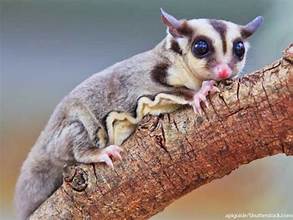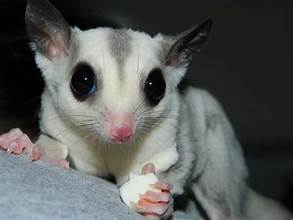Leopard Geckos are among the most beloved pet reptiles, celebrated for their striking appearance, manageable size, and relatively low-maintenance care needs. For those considering bringing a Leopard Gecko into their home, understanding their habitat requirements and overall care is crucial to ensuring these charming lizards thrive. Understanding Leopard Gecko Habitat Needs
The most critical detail of Leopard Gecko care is creating a comfortable and suitable habitat. A well-set-up enclosure will mimic the leopard gecko’s natural environment and provide the conditions for their health and happiness.
1. Choosing the Right Enclosure
The first step in setting up your Leopard Gecko’s home is selecting the appropriate enclosure. A 20-gallon tank is needed for a single adult Leopard Gecko. Glass terrariums with secure lids are ideal as they provide excellent visibility and retain heat well.
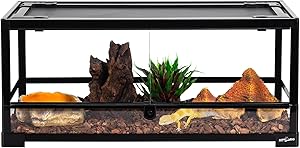
For those planning to house multiple geckos together, ensure the enclosure is large enough to provide ample space for each gecko. However, it’s important to note that males should be housed in separate tanks as they can become territorial and aggressive.
2. Substrate: What’s Safe and What to Avoid
Substrate refers to the material that lines the bottom of your Leopard Gecko’s enclosure. A suitable substrate is crucial for their safety and comfort.
Safe Substrate Options:
Reptile Carpet:
The right choice is a reusable option that’s easy to keep clean and safe for your gecko.
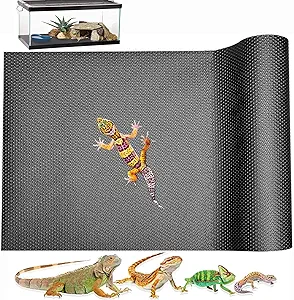
Paper Towels:
It is an inexpensive, disposable option beneficial for young geckos or those with health issues.
Slate Tiles:
These mimic the natural rocky environment and provide a solid, easy-to-clean surface.
Substrates to Avoid:
Sand:
Although it may seem natural, sand can cause impaction if ingested, a severe health issue where the digestive tract becomes blocked.
Loose Substrates:
Substrates like wood shavings, coconut fiber, or gravel are not recommended due to the risk of impaction.
3. Temperature and Lighting:
Maintaining the Perfect Environment
Leopard Geckos are ectothermic, meaning they need external heat sources to regulate their body temperature. Therefore, creating a temperature gradient within the enclosure is vital.
Warm Side:
You should keep the warm side at 88°F to 92°F. An under-tank heater or heat mat can achieve this.
Cool Side:
You should keep the cool side around 75°F. This gradient allows your gecko to move between warmer and cooler areas to regulate body temperature.
Nighttime Temperatures:
At night, temperatures can safely drop to around 70°F. No additional heating is typically needed unless your home gets significantly cooler.
Lighting:
Leopard Geckos do not need UVB lighting, but providing a light cycle that mimics natural day and night is beneficial. Use a low-wattage bulb for this purpose, and ensure the enclosure is dark at night to allow for proper rest.
4. Humidity and Hydration
Leopard Geckos originate from arid environments, so keeping the enclosure’s humidity low is essential. Aim for a humidity level of around 30-40%. To assist with shedding, provide a humid hide—a small enclosed area with higher humidity—by placing damp sphagnum moss or a moistened paper towel inside.
Always provide a shallow dish of fresh water in the enclosure. While Leopard Geckos don’t drink large amounts of water, it’s crucial for hydration.
5. Essential Decor and Hides
In addition to the basic setup, certain items can enhance your Leopard Gecko’s habitat and provide necessary enrichment:
Hides:
Leopard Geckos need at least two hides—one on the warm and one on the excellent sides of the tank. Hides provide a sense of security and a place to retreat and rest.
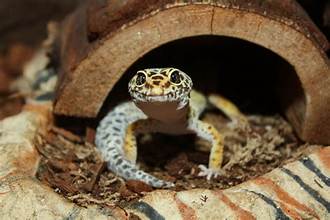
Climbing Structures:
While not arboreal, Leopard Geckos enjoy climbing on rocks, branches, and other low structures.
Food Dish:
A shallow dish for live insects or calcium powder can keep the enclosure tidy and make feeding easier.
Thermometers and Hygrometers:
These tools are needed to monitor the temperature and humidity levels in the enclosure.
Additional Care Information for Prospective Owners
Diet and Feeding:
Leopard Geckos are insectivores, meaning their diet consists primarily of live insects like crickets, mealworms, and dubia roaches. Ensure the insects are gut-loaded (fed a nutritious diet) before offering them to your gecko, and dust them with calcium powder and a vitamin D3 supplement to prevent metabolic bone disease.
Handling and Temperament:
Leopard Geckos are generally docile, and you can hold them regularly, but starting slow and building trust is essential. Keep them gently and their entire body to avoid stress or injury.
Health and Lifespan:
Leopard Geckos live up to 15-20 years in captivity with proper care. Regular veterinary check-ups are needed to monitor their health and catch any issues early.
Conclusion
Leopard Geckos are an excellent choice for reptile enthusiasts due to their manageable care requirements and charming personalities. You can ensure your Leopard Gecko thrives in its new home by providing a well-maintained habitat with the right temperature, lighting, and enrichment. With the proper care and attention, these fascinating creatures will bring years of enjoyment to any household.

